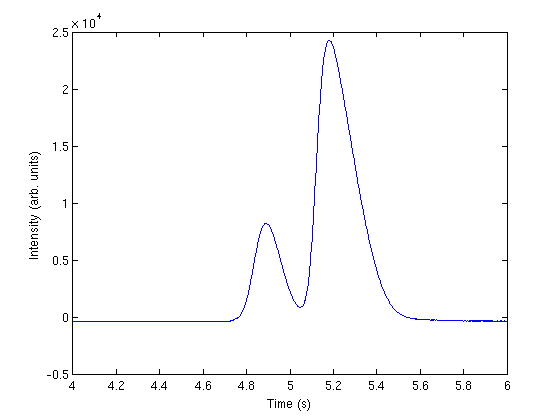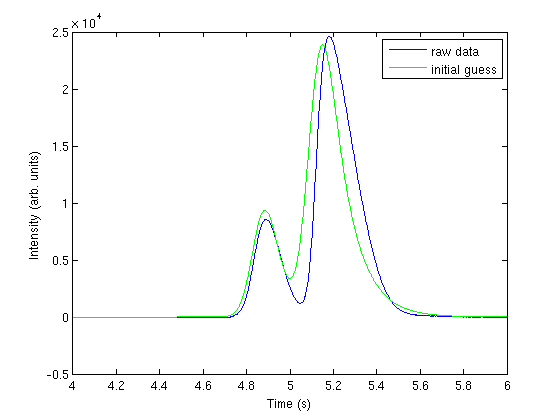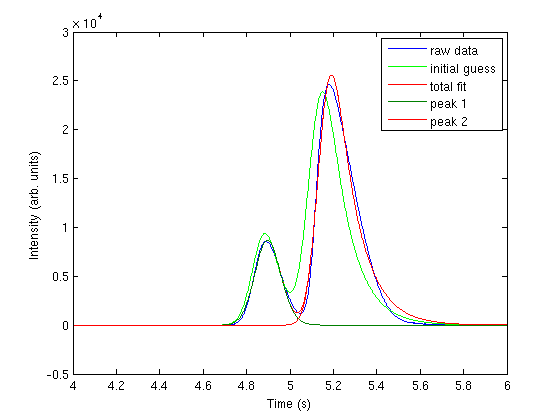curve fitting to get overlapping peak areas
June 22, 2012 at 08:33 PM | categories: data analysis | View Comments
Contents
- curve fitting to get overlapping peak areas
- read in the data file
- first we get the number of data points, and read up to the data
- initialize the data vectors
- now read in the data
- Plot the data
- correct for non-zero baseline
- a fitting function for one peak
- a fitting function for two peaks
- Plot fitting function with an initial guess for each parameter
- nonlinear fitting
- now extract out the two peaks and integrate the areas
- Compute relative amounts
curve fitting to get overlapping peak areas
John Kitchin
Today we examine an approach to fitting curves to overlapping peaks to deconvolute them so we can estimate the area under each curve. You will need to download gc-data-2.txt for this example. This file contains data from a gas chromatograph with two peaks that overlap. We want the area under each peak to estimate the gas composition. You will see how to read the text file in, parse it to get the data for plotting and analysis, and then how to fit it.
function main
read in the data file
The data file is all text, and we have to read it in, and find lines that match certain patterns to identify the regions that are data, then we read in the data lines.
clear all; close all datafile = 'gc-data-2.txt'; fid = fopen(datafile);
first we get the number of data points, and read up to the data
i = 0; while 1 line = fgetl(fid); sm = strmatch('# of Points',line); if ~isempty(sm) regex = '# of Points(.*)'; [match tokens] = regexp(line,regex,'match','tokens'); npoints = str2num(tokens{1}{1}); elseif strcmp(line,'R.Time Intensity') break i = i + 1 end end
initialize the data vectors
t = zeros(1,npoints); intensity = zeros(1,npoints);
now read in the data
for j=1:npoints line = fgetl(fid); [a] = textscan(line,'%f%d'); t(j) = a{1}; intensity(j) = a{2}; end fclose(fid);
Plot the data
plot(t,intensity) xlabel('Time (s)') ylabel('Intensity (arb. units)') xlim([4 6])

correct for non-zero baseline
intensity = intensity + 352; plot(t,intensity) xlabel('Time (s)') ylabel('Intensity (arb. units)') xlim([4 6])

a fitting function for one peak
The peaks are asymmetric, decaying gaussian functions.
function f = asym_peak(pars,t) % from Anal. Chem. 1994, 66, 1294-1301 a0 = pars(1); % peak area a1 = pars(2); % elution time a2 = pars(3); % width of gaussian a3 = pars(4); % exponential damping term f = a0/2/a3*exp(a2^2/2/a3^2 + (a1 - t)/a3)... .*(erf((t-a1)/(sqrt(2)*a2) - a2/sqrt(2)/a3) + 1); end
a fitting function for two peaks
to get two peaks, we simply add two peaks together.
function f = two_peaks(pars, t) a10 = pars(1); % peak area a11 = pars(2); % elution time a12 = pars(3); % width of gaussian a13 = pars(4); % exponential damping term a20 = pars(5); % peak area a21 = pars(6); % elution time a22 = pars(7); % width of gaussian a23 = pars(8); % exponential damping term p1 = asym_peak([a10 a11 a12 a13],t); p2 = asym_peak([a20 a21 a22 a23],t); f = p1 + p2; end
Plot fitting function with an initial guess for each parameter
the fit is not very good.
hold all; parguess = [1500,4.85,0.05,0.05,5000,5.1,0.05,0.1]; plot (t,two_peaks(parguess,t),'g-') legend 'raw data' 'initial guess'

nonlinear fitting
now we use nonlinear fitting to get the parameters that best fit our data, and plot the fit on the graph.
pars = nlinfit(t,intensity, @two_peaks, parguess) plot(t,two_peaks(pars, t),'r-') legend 'raw data' 'initial guess' 'total fit'
pars =
1.0e+03 *
1.3052 0.0049 0.0001 0.0000 5.3162 0.0051 0.0000 0.0001

the fits are not perfect. The small peak is pretty good, but there is an unphysical tail on the larger peak, and a small mismatch at the peak. There is not much to do about that, it means the model peak we are using is not a good model for the peak. We will still integrate the areas though.
now extract out the two peaks and integrate the areas
pars1 = pars(1:4) pars2 = pars(5:8) peak1 = asym_peak(pars1, t); peak2 = asym_peak(pars2, t); plot(t,peak1) plot(t,peak2) legend 'raw data' 'initial guess' 'total fit' 'peak 1' 'peak 2'; area1 = trapz(t, peak1) area2 = trapz(t, peak2)
pars1 =
1.0e+03 *
1.3052 0.0049 0.0001 0.0000
pars2 =
1.0e+03 *
5.3162 0.0051 0.0000 0.0001
area1 =
1.3052e+03
area2 =
5.3162e+03

Compute relative amounts
percent1 = area1/(area1 + area2) percent2 = area2/(area1 + area2)
percent1 =
0.1971
percent2 =
0.8029
This sample was air, and the first peak is oxygen, and the second peak is nitrogen. we come pretty close to the actual composition of air, although it is low on the oxygen content. To do better, one would have to use a calibration curve.
end % categories: data analysis % post_id = 1994; %delete this line to force new post; % permaLink = http://matlab.cheme.cmu.edu/2012/06/22/curve-fitting-to-get-overlapping-peak-areas/;